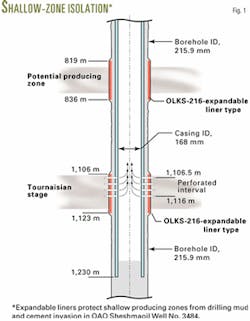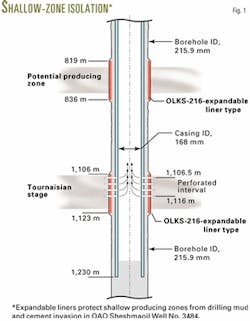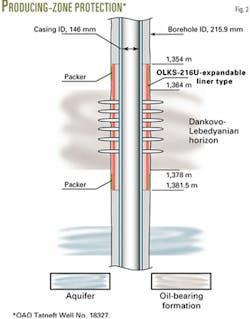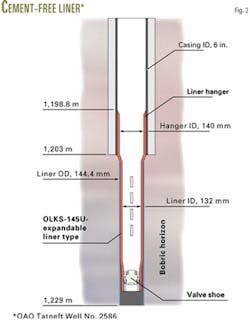Expandable-profile liners have successfully isolated and protected permeable hydrocarbon zones in Russian oil wells, minimizing formation damage from invasion of drilling fluids and cement slurries.
By minimizing formation damage with expandable liners, the operating company OAO Tatneft has improved production rates by as much as 1.4-2 times the flow from wells completed with conventional cemented liners.
Protecting possible producing formations from cement slurry and drilling fluid invasion is one of the most important well-construction objectives. Expandable-liner installations, without behind-the-liner cementing, have proven effective in improving well performance.
Shallow zones
Wells in many Russian oil and gas fields pass through permeable formations before reaching the main pay or primary zone of interest, which is the well's primary well completion target.
Many of these secondary zones have commercial hydrocarbon volumes that the operator must preserve for future production.
When drilling into and completing the main pay, operators can apply various technologies such as balanced and underbalanced drilling. Certain regulatory requirements and environmental policies may also govern specific well completion activities.
In the Republic of Tatarstan, when operators drill into the Devonian formations, the wellbores often intersect commercial beds within the Middle and Lower Carboniferous age.
The water-based muds, containing heavy clays, circulate past the zones exposing them to potential invasion and formation damage.
Drilling contractors also encounter complicated lost-circulation problems in the Serpukhovian-Okkian, Lower Famennian, and Upper Famennian sediments. The inert filling agents used in lost-circulation materials, such as sawdust, cord fiber, and fiber-filling agents, lead to formation contamination.
Drillstring trips create pressure fluctuations that range 3.5-4.0 MPa (508-580 psi). The pressure surges cause fluid losses to increase, contributing to formation damage.
Proper cement job design and well cementing requires cement circulation to surface. The resulting hydraulic loading and hydrostatic pressure, however, often cause partial or complete formation fracturing and subsequent irrevocable permeability loss in the affected zone.
The only way to preserve formation permeability of producing zones, penetrated by a well, is drilling the zone under pressure-balanced conditions and isolating the interval with an expansion liner. OAO Tatneft has developed and perfected the method and has used it widely.
Zone isolations
To penetrate the producing Pashiyskian horizon, the operator OAO Sheshmaoil had planned to drill the Letneye oil field Well No. 3484 to 1,802-m TD. The company drilled the producing intervals in the Bashkirian and Tournaisian stages with 1,050-kg/cu m (8.8-ppg) polymer drilling mud.
The rig set expandable-profile liners, known as OLKS-216, in the intervals 819-836 m and 1,106-1,123 m. The liners isolated the zones without loss of wellbore diameter and without cementing (Fig.1).
Since the well encountered no oil-producing formations in the Devonian terrigenous sediments, the company isolated pressure from the lower beds with cement plugs and ran and cemented production casing to 1,230 m.
Crews then perforated through the casing, cement sheath, and profile liner in the Tournaisian interval, 1,106.5-1,116 m, using the perforating-tool assembly called ZPK-105S.
Compared to adjacent wells, drilled and completed with conventional technology, the well currently produces at twice the production rate.
OAO Tatneft's Well No. 18327, in the Zelenogorskaya area operations, presents another example.
The company successfully isolated the 14-m thick producing interval of the Dankovo-Lebedyanian horizon with a 27.5-m long section of expandable-profile liner, of the type OLKS-216U. Drilling operations then ran and cemented production casing (Fig. 2).
By use of the liner, the company prevented cement-slurry invasion into the permeable channels of the producing formation.
Crews perforated the production casing string, the cement sheath, and the liner with the perforator called PK-103. The well's production rate was 40% higher compared to that of neighboring wells.
Liner completions
Local and international well-completion experience has demonstrated the most effective way of preserving reservoir permeability is to set and cement production casing at the top of the targeted reservoir before drilling into oil-bearing zones that are planned for production.
This allows operators to drill into the reservoir with lightened, high-quality drilling muds for optimum pressure balance, and minimizing fluid invasion, before running the liner or sand-screen completion. The method also significantly reduces drilling mud and chemical agent consumption.
The practice of casing-off completion intervals with conventional or reduced-diameter liners often causes loss of cement-sheath quality, cement slurry invasion into the reservoir pore channels, and problems during production.
A team of engineers and scientists from the Tatar Oil Research & Design Institute (TatNIPIneft) has developed the technology and equipment for casing the producing formations, without cementing and without wellbore diameter loss, with expandable-profile pipes or tubulars.
The team built the custom-made liner for this special application from expandable-profile tubulars, known as OLKS-145U, and a liner hanger made from a 4-m long expandable-profile pipe section with packer elements on each end.
Case histories
OAO Tatneft has completed numerous wells in Tatarstan with noncemented expandable-profile liners. The company cites three examples: Well Nos. 2586, 2583, and 2582, all drilled in the Melnikovskoye oil field.
The rig drilled Well No. 2586 with a 215.9-mm bit to 1,203 m, casing the hole with 168-mm conventionally cemented casing (Fig. 3).
Crews drilled into the Bobric horizon producing interval, 1,203-29 m, with a 144.4-mm drill bit, known as U114,4SF-45.
The rig circulated and flushed the well to bottomhole with 1,060-kg/cu m (8.85 ppg) polymer drilling mud, with viscosity of 25-26 sec, and water loss of 4 cc/30 min. Drilling operations averaged 6.5 m/hr penetration rate and completed the interval in 3.7 hr of total bottom time.
Crews cased the completion interval with the expandable-profile liner and perforated the well with a TatNIPIneft designed hydromechanical perforator (Fig. 3). The liner perforations were 12 mm wide, 40 mm long, and 26 perforations per interval.
The company drilled and completed Well Nos. 2582 and 2583 with the same noncemented expandable-profile liners as Well No. 2586.
The well productivities were 69% higher compared to neighboring wells that the company drilled from the same cluster site but using the conventional technology of setting and cementing production casing across the pay zone.
Table 1 shows the production comparison for the two completion methods with wells completed with noncemented expandable liners producing an average oil rate of 16.4 cu m/day compared to 9.7 cu m/day for the conventional cemented liner completions.
The authors
Shafagat F. Takhautdinov is the director general of the joint stock company OAO Tatneft. He graduated in 1971 as a mining engineer from the Moscow Petrochemical and Gas Institute, from which he also holds a PhD in technical science.
Nail G. Ibragimov is the first deputy of director general of the joint stock company OAO Tatneft. He graduated from the Moscow Petrochemical and Gas Institute as a mining engineer and holds a PhD in technical science. He is one of the developers of the unique technology on recovery of hard recoverable reserves from old oilfields.
Gabdrashit S. Abdrakhmanov is a chief drilling expert in the External Economic Co. of the joint stock company OAO Tatneft. He graduated from the Moscow Petrochemical and Gas Institute and holds a PhD in technical science. He is a professor and corresponding member of the Russian Academy of natural sciences with more than 20 years of experience in local casing of wells.
Izil G. Yusupov is a first deputy director on well construction and workover at Tatar Oil Research and Design Institute (TatNIPIneft) and is a professor. He graduated from the Ufa Petroleum Institute and holds a doctorate in technical science.
Nigmatyan K. Khamityanov is a head of well construction and workover department in Tatar Oil Research and Design Institute (TatNIPIneft). He graduated from the Ufa Petroleum Institute and has 10 years' experience in local well casing using profile liners.
Ilyas A. Urazgildin is a senior research worker in the well construction and workover department in Tatar Oil Research and Design Institute (TatNIPIneft). In 1984 he graduated from the Ufa Petroleum Institute as a mechanical engineer.
Vitaly P. Filippov is a senior research worker in the well construction and workover department in Tatar Oil Research and Design Institute (TatNIPIneft). In 1975, he graduated from the Kazan Civil Engineering Institute.





